A Botanical Walk Through the Maquis and Garrigue
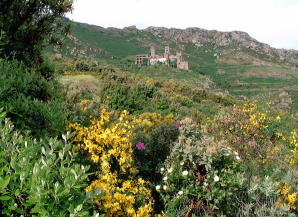
Springtime transforms the bare, apparently infertile landscape of the Empordà for a short time into a sea of blooms and scents. In the thin, nutrient-poor limestone soil there thrives a whole range of perennial plants that have developed true survival arts in adapting to the aridity of the summer, the often extreme wind and the stony ground. The grey and brown of the landscape transforms into rich green, and the yellow of the luxuriant broom contrasts with the pink and purple flowers of rockroses and wild lavender..
In order to combat the evaporation, the plants have reduced leaf surface or reflect the sunlight with silvery leaves. Succulents store the water in their thick fleshy leaves. Other plants have leaves that are furry or covered in a layer of wax, in order to catch the dew or stop the loss of water. There are also plants that have developed strong aromatic oils, their scents forming a protecting cloud around.

This carpet of multicoloured blooms reaches right to the coast. The aromatic smell of the oils of wild herbs such as rosemary and thyme, sage and fennel mixes with the scents from the flowers and a walk through this landscape becomes a sensuous experience. In the autumn, this sumptuous splendour is renewed for a short time. In the summer, though, the plants hold a kind of “summer sleep”: they withdraw into their roots or bulbs and shed their leaves and stalks. Jealously guarding their reserves, they are the first to flower again in the spring.
Maquis & Garrigue
Maquis and garrigue are landscape forms that developed from the progressive destruction of former broadleaf and coniferous forests. In the time of the Romans and Greeks, these forests were heavily exploited. Wood was used for buildings and ships, and it was also needed for furnaces for metal extraction, dyeing cloth and glassmaking. The bark of the trees was used for leather tanning, which was extremely popular with the Romans. Over-grazing by sheep and goats plus forest fires contributed strongly to the reduction in woodlands. The maquis was the first stage in the shrinking of the once rich forests. Tree felling also reduced the associated undergrowth, causing the spread of a shrub forest, about 2-4 metres in height, with slow-growing small trees and bushes.
Where the maquis, following the receding forests, then failed, the garrigue developed, usually with lower evergreen bushes and scrub, often isolated and exposing the meagre rocky soil. On this, rock roses, broom, wild lavender, rosemary and thyme among other things formed low clumps. To sum up, and by way of distinction, we can say that the garrigue scratches your feet, while the maquis pokes you in the eye.
Of the trees of the maquis, the holm oak (quercus ilex) should be mentioned because, but forest and soil destruction, it would provide the most important tree cover of the Mediterranean area. Then there is the stone pine (Pinus pinea), easily recognisable because of its upward opening crown, which gives it its alternative English name, the umbrella pine. Likewise the cork oak (quercus suber), whose thick bark is used for various purposes, apart from wine corks! The first cork harvest is possible only after 20-25 years, after which a tree can be peeled every 10-12 years up to an age of 150 years.
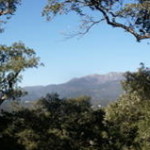 Quercus suber |
 Quercus suber |
Another typical tree of the maquis is the arbutus, or strawberry-tree (arbutus unedo), though this is more commonly found in Corsica and Italy. The photos were taken in the area around Darnius. It is an evergreen bush or tree with reddish wood. It is beautiful in the autumn when the white blossom hangs from it at the same time as the strawberry-like fruits. The round fruits change from green through yellow to red. “Unedo” means “I eat only one” (and never again!) because many people find the taste horrible.
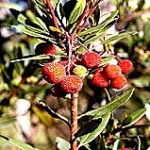 Arbutus unedo |
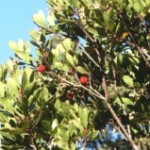 Arbutus unedo |
In the underbrush of both the maquis and the garrigue, the tree heather (erica arborea) grows rampantly. A member of the family ericaceae, it flourishes in nutrient-poor acid soils. This evergreen shrub flowers from May to July with white tiny flowers. The small needle-like leaves are arranged in such a way that they give themselves shade. The branches of the heather can be used for domestic brooms, while the root provides the wood for briar pipes.
The evergreen mastic tree (pistacia lentiscus) has inconspicuous fruits, which are red and then turn completely black. Mastic is a granular resin, which is used in varnishes and for medicines, and since Roman times has been used as chewing gum – hence its name.
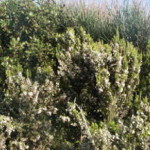 Erica arborea |
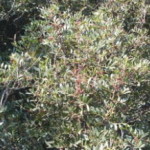 Pistacia lentiscus |
The yellow splendour of broom is remarkable and seems to colour the mountains in spring. There are many kinds of broom (genista), which belong to the family of the fabaceae. The spiny broom (calicotome villosa) is a low shrub with dense flowers and sharp thorns. The Spanish broom (spartium junceum) is a tall bush with nearly leafless green stems that have taken over the task of photosynthesis and whose flowers at the tips take the form of grapes. Brooms contain poisonous alkaloids that are used in pharmaceutics.
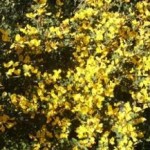 Calicotome villosa |
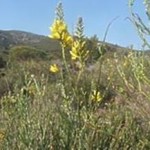 Spartium junceum |
A typical plant of the garrigue, which grows right up to the coast, is the rockrose (cistus cretius). The cistaceae family alone contains 17 species and is a little like the brier rose. Rockroses open their delicate crumpled flowers in the sun and fall in the evening as a petal carpet. The small leaves are covered with a layer of fine hair, in order to reduce aromatic scent and evaporation.
Labdanum resin, collected from the hairs on the stems and leaves, is used in the production of perfume and has long been known as a healing agent. It strengthens the immune system, fights bacteria, viruses and fungal infection and is also used as a fixative. It is also used in a Bach Flower Remedy for treating panic disorder. The white flowering varieties include the Montpelier rockrose (cistus monspeliensis) with sticky and strongly smelling aromatic oils in the leaves and the sage-leaf rockrose (cistus salvifolius), which is more branched and whose leaves are not sticky.
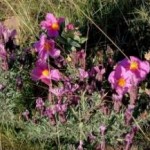 Cistus creticus |
 Cistus creticus |
 Cistus monspeliensis |
Spanish lavender (lavendula stoechas) is a perennial shrub of the labiatae (lamiaceae) or mint family that grows vigorously and contains aromatic oils and saponin, which is used in tanning. It has a marvellous comforting smell. The upper petals of the flowers are bright to attract insects. Before use, the flowers must be hung up to dry. They are popular to make small lavender bags for hanging in the wardrobe. Lavender oil is used in making a relaxing bath.
 Lavendula stoechas |
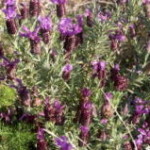 Lavendula stoechas |
The tree mallow (lavatera arborea) belongs to the mallow family (malvaceae). It is often to be found in rocky coastal regions and grows very tall.
Further down towards the shore many wild flowers may be found, such as the purple viper’s bugloss (echium plantagineum) with its bristly leaves and blue-violet flowers.
The crown daisy (Chrysanthemum coronarium) pleases with its bright yellow hue and can plunge whole fields into this colour.
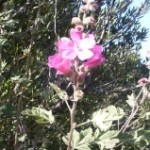 Lavatera arborea |
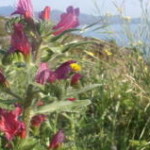 Echium plantagineum |
 Chrysanthenum coronarium |
Rosy garlic (allium roseum) is an example of a lily plant (liliaceae) with a bulb, which serves as underground nutrient reservoir. Under intense heat it casts off the upper plant and withdraws into the soil. The bulb serves as storehouse and this plant becomes the first to flower the following spring.
The mallow-leaved bindweed (convolvulus althaeoides) has hairy leaves and grows rampant over the ground or entwines itself in bushes and shrubs.
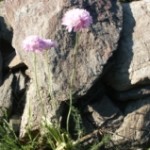 Allium roseum |
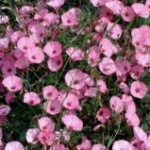 Convolvulus althaeoides |
The blue or violet morning glory (ipomoea purpurea) also covers large areas. It is a climber with remarkably large blooms, suitable too for garden fences and trellises.
The nearer we approach the shore, the smaller the plants get, and they blow with the wind. The most remarkable colour is provided by the sumptuous carpet of mesembryanthemum, or sally-my-handsome (carpobrotus acinaciformis), which belongs to the ice plant family (aizoaceae). Its splendid sharp colour lasts only a short time, as with many water-storing plants. The flower colours vary from pink to white-yellowish or as here carmine to pink. They form close-knit wide carpets, whose fleshy sharp-edged leaves are connected at ground level and among themselves. This very vigorous plant is a genuine sun-worshipper, for the blooms close in its absence. Apart from being a genuine ornament, it is also useful for stabilising slopes. Its original homeland is South Africa.
 Carpobrotus acinaciformi |
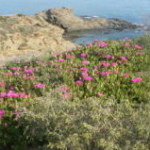 Carpobrotus acinaciformi |
Everywhere in the coastal region one finds thymelaea (thymelaea hirsuta), with its hanging branches. The false sowthistle (reichardia tingitana) is very undemanding and grows on sand and rock by the shore; its yellow flower shines with a violet inner ring like a small sunflower, and it is also popular in Mediterranean gardens.
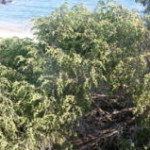 Thymelaea hirsuta |
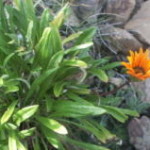 Tanger-Reichardie |
This is only a small selection of the many wild Mediterranean plant types, which often look quite inconspicuous until through rain and sun they reveal their beauty and splendid colours. Rambles through the mountains and nature reserves of the Empordà are richly-rewarded journeys of discovery.


WONDERFULLY ELUCIDATORY DESCRIPTIONS of my favourite area for flowers and their scents.
THANK YOU!
Thank you for your comment, Piers!
I would like to get in touch with the author if possible ?
Regards
Chris
Hello, I wanted to know about this plant named Mackiya or Maquis. How can I contact you?